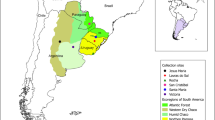Abstract
The redlegged earth mite (Halotydeus destructor) and the blue oat mite (Penthaleus major) are major pests of pastures and crops in southern Australia. Reproductive modes, migration rates and levels of differentiation between populations were investigated using allozyme electrophoresis. Collections were made throughout Victoria and a sample was also obtained from Western Australia. Three enzyme loci were polymorphic in H. destructor (Mdh-1, Mdh-2 and Idh). Genotype frequencies of these loci did not differ between phenotypic males and females, providing no evidence for haplodiploidy. Allele frequencies were in Hardy-Weinberg equilibrium, indicating that H. destructor is diploid and sexual. This was confirmed via crosses between males and females. Allele frequencies differed between Victorian sites, although F statistics indicated little differentiation over all loci. A sample from Western Australia did not differ in allele frequencies from the Victorian sites. Four polymorphic loci were found in P. major (Mdh-1, Mdh-2, Idh and Gpi). Only a few multilocus genotypes occurred in a sample, indicating that P. major is parthenogenic. No male P. major were found in this study. A number of colour morphs were also identified and a genetic association between genital plate colour and clonal type was found in one population of P. major. Two different body colour morphs were associated with different clonal types.
Similar content being viewed by others
References
Annells, A.J. 1994. The reproductive biology and mating behaviour of redlegged earth mite: an overview. In Proceedings of the Second National Workshop on Redlegged Earth Mite, Lucerne Flea and Blue Oat mite, G. McDonald and A.A. Hoffmann (eds), pp. 29–31. Victorian Printing, Blackburn, Victoria.
Bureau of Meteorology 1993. Monthly review. Bureau of Meteorology, Victoria.
Coates, D.J. 1988. Genetic diversity and population genetic structure in the rare chittering grass wattle, Acacia anomala court. Aust. J. Botany 36: 273–286.
Daly, J.C. and Gregg, P. 1985. Genetic variation in Heliothis in Australia: species identification and gene flow in the two pest species H. armigera (Hubner) and H. punctigera Wallengren (Lepidoptera: Noctuidae). Bull. Entomol. Res. 75: 169–184.
Hartl, D.L. and Clark, A.G. 1989. Principles of Population Genetics 2nd edn, pp. 31–32, 301–305. Sinauer Associates, Inc., Sunderland, MA.
James, D.G. 1992. Earth mite management. Farmers' Newslett, Large Area 139: 27–30.
Korman, A.K., Mallet, J., Goodenough, J.L., Graves, J.B., Hayes, J.L., Hendricks, D.E., Luttrell, R., Pair, S.D. and Wall, M. 1993. Population structure in Heliothis virescens (Lepidoptera: Noctuidae): an estimate of gene flow. Ann. Entomol. Soc. Am. 86: 182–188.
Maynard Smith, J. 1978. The Evolution of Sex, pp. 42–43. Cambridge University Press, Cambridge.
Meyer, M.K.P. and Ryke, P.A.J. 1960. Mites of the superfamily Eupodidea (Acarina: Prostigmata) associated with South African plants. S. Afr. J. Agricult. Sci. 3: 481–496.
Narayan, D.H. 1962. Morphological, biological and ecological studies on the winter grain mite, Penthaleus major (Duges), Penthaleidae; Acarina Part I. J. Zool. Soc. India 14: 45–63.
Newman, L.J. 1925. The red legged earth mite Penthaleus destructor (Jack). J. Dep. Agricult. W. Aust. (Second Series) 2: 469–475.
Norton, R.A., Kethley, J.B., Johnston, D.E. and O'Connor, B.M. 1993. Phylogenetic perspectives on genetic systems of reproductive modes of mites. In Evolution and diversity of sex ratio in mites and insects, D.L. Wrensch and M.A. Ebbert (eds). Chapman & Hall, New York.
Palmer, S.C. and Norton, R.A. 1992. Genetic diversity in thelytokous oribatid mites (Acari; Acaiformes: Desmonomata). Biochem. System. Ecol. 20: 219–231.
Qin, T.K. and Halliday, R.B. 1995. Systematics of redlegged earth mite and related species (Acarina: Penthaleidae). Plant Protect. Q. 10: 50–52.
Rice, W.R. 1989. Analyzing tables of statistical tests. Evolution 43: 223–225.
Richardson, B.J., Baverstock, P.R. and Adams, M. 1986. Allozyme Electrophoresis: A Handbook for Animal Systematics and Population Studies. Academic Press, Australia.
Ridsdill-Smith, T.J. 1991a. Biology and ecology of redlegged earth mite, blue oat mite and lucerne flea. In Proceedings of a National Workshop on Redlegged Earth Mite, Lucerne Flea and Blue Oat Mite, T.J. Ridsdill-Smith (ed.), pp. 36–41. Department of Agriculture, Western Australia, South Perth.
Ridsdill-Smith, T.J. 1991b. A contribution to assessing the economic impact of redlegged earth mite on agricultural production in Australia. In Proceedings of a National Workshop on Redlegged Earth Mite, Lucerne Flea and Blue Oat Mite, T.J. Ridsdill-Smith (ed.), pp. 53–56. Department of Agriculture, Western Australia, South Perth.
Ridsdill-Smith, T.J. 1991c. Laboratory rearing of Halotydeus destructor (Tucker) (Acari: Penthaleidae). J. Aust. Entomol. Soc. 30: 313.
Silver, A.R.J., Van-Emden, H.F. and Battersby, M. 1995. A biochemical mechanism of resistance to pirimicarb in two glasshouse clones of Aphis gossypii. Pestic. Sci. 43: 21–29.
Slatkin, M. and Barton, N.H. 1989. A comparison of three indirect methods for estimating average levels of gene flow. Evolution 43: 1349–1368.
Suzuki, K., Hama, H. and Konno, Y. 1993. Carboxylesterase of the cotton aphid, Aphis gossypii Glover (Homoptera: Aphididae), responsible for fenitrothion resistance as a sequestering protein. Appl. Entomol. Zool. 28: 439–450.
Swofford, D.L. and Selander, R.B. 1981. BIOSYS-1: a FORTRAN program for the comprehensive analysis of electrophoretic data in population genetics and systematics. J. Hered. 72: 281–283.
Tucker, R.W.E. 1925. The black sand mite: Penthaleus destructor n.sp. Dep. Agricult. S. Afr. Entomol. Mem. 3: 21–36.
Weir, B.S. 1990. Genetic Data Analysis: Methods for Discrete Population Genetic Data, pp. 340–348. Sinauer Associates, Inc., Sunderland, MA.
Womersley, H. 1993. On some Acarina from Australia and South Africa. Trans. R. Soc. S. Aust. 57: 108–112.
Wright, S. 1969. Evolution and the Genetics of Populations, Vol. 2. The Theory of Gene Frequencies, pp. 290–293. University of Chicago Press, Chicago.
Wright, S. 1978. Evolution and the Genetics of Populations, Vol. 4. Variability Within and Among Natural Populations. University of Chicago Press, Chicago.
Author information
Authors and Affiliations
Rights and permissions
About this article
Cite this article
Weeks, A.R., Fripp, Y.J. & Hoffmann, A.A. Genetic structure of Halotydeus destructor and Penthaleus major populations in Victoria (Acari: Penthaleidae). Exp Appl Acarol 19, 633–646 (1995). https://doi.org/10.1007/BF00145252
Issue Date:
DOI: https://doi.org/10.1007/BF00145252




